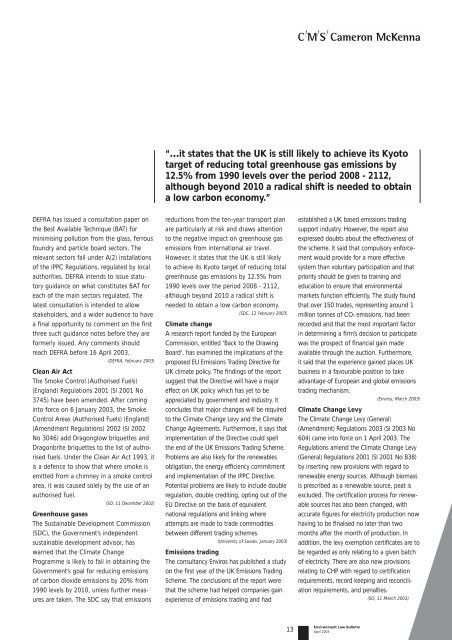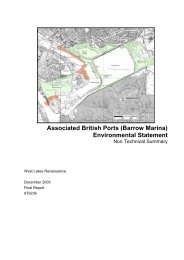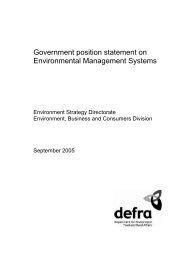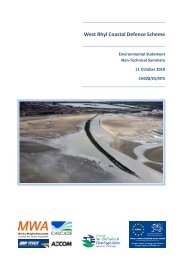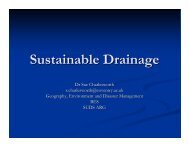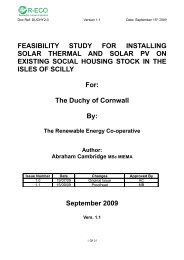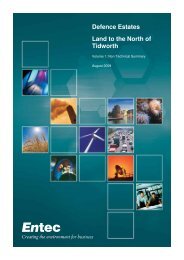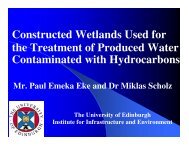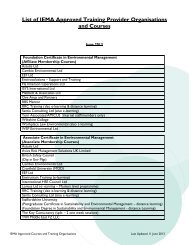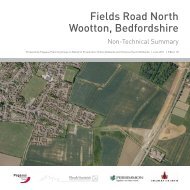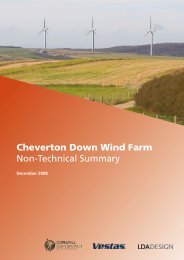Environment Law Bulletin - Institute of Environmental Management ...
Environment Law Bulletin - Institute of Environmental Management ...
Environment Law Bulletin - Institute of Environmental Management ...
Create successful ePaper yourself
Turn your PDF publications into a flip-book with our unique Google optimized e-Paper software.
“…it states that the UK is still likely to achieve its Kyototarget <strong>of</strong> reducing total greenhouse gas emissions by12.5% from 1990 levels over the period 2008 - 2112,although beyond 2010 a radical shift is needed to obtaina low carbon economy.”DEFRA has issued a consultation paper onthe Best Available Technique (BAT) forminimising pollution from the glass, ferrousfoundry and particle board sectors. Therelevant sectors fall under A(2) installations<strong>of</strong> the IPPC Regulations, regulated by localauthorities. DEFRA intends to issue statutoryguidance on what constitutes BAT foreach <strong>of</strong> the main sectors regulated. Thelatest consultation is intended to allowstakeholders, and a wider audience to havea final opportunity to comment on the firstthree such guidance notes before they areformerly issued. Any comments shouldreach DEFRA before 16 April 2003.(DEFRA, February 2003)Clean Air ActThe Smoke Control (Authorised Fuels)(England) Regulations 2001 (SI 2001 No3745) have been amended. After cominginto force on 6 January 2003, the SmokeControl Areas (Authorised Fuels) (England)(Amendment Regulations) 2002 (SI 2002No 3046) add Dragonglow briquettes andDragonbrite briquettes to the list <strong>of</strong> authorisedfuels. Under the Clean Air Act 1993, itis a defence to show that where smoke isemitted from a chimney in a smoke controlarea, it was caused solely by the use <strong>of</strong> anauthorised fuel.(SO, 11 December 2002)Greenhouse gasesThe Sustainable Development Commission(SDC), the Government’s independentsustainable development advisor, haswarned that the Climate ChangeProgramme is likely to fail in obtaining theGovernment’s goal for reducing emissions<strong>of</strong> carbon dioxide emissions by 20% from1990 levels by 2010, unless further measuresare taken. The SDC say that emissionsreductions from the ten-year transport planare particularly at risk and draws attentionto the negative impact on greenhouse gasemissions from international air travel.However, it states that the UK is still likelyto achieve its Kyoto target <strong>of</strong> reducing totalgreenhouse gas emissions by 12.5% from1990 levels over the period 2008 - 2112,although beyond 2010 a radical shift isneeded to obtain a low carbon economy.(SDC, 12 February 2003)Climate changeA research report funded by the EuropeanCommission, entitled ‘Back to the DrawingBoard’, has examined the implications <strong>of</strong> theproposed EU Emissions Trading Directive forUK climate policy. The findings <strong>of</strong> the reportsuggest that the Directive will have a majoreffect on UK policy which has yet to beappreciated by government and industry. Itconcludes that major changes will be requiredto the Climate Change Levy and the ClimateChange Agreements. Furthermore, it says thatimplementation <strong>of</strong> the Directive could spellthe end <strong>of</strong> the UK Emissions Trading Scheme.Problems are also likely for the renewablesobligation, the energy efficiency commitmentand implementation <strong>of</strong> the IPPC Directive.Potential problems are likely to include doubleregulation, double crediting, opting out <strong>of</strong> theEU Directive on the basis <strong>of</strong> equivalentnational regulations and linking whereattempts are made to trade commoditiesbetween different trading schemes.(University <strong>of</strong> Sussex, January 2003)Emissions tradingThe consultancy Enviros has published a studyon the first year <strong>of</strong> the UK Emissions TradingScheme. The conclusions <strong>of</strong> the report werethat the scheme had helped companies gainexperience <strong>of</strong> emissions trading and hadestablished a UK based emissions tradingsupport industry. However, the report alsoexpressed doubts about the effectiveness <strong>of</strong>the scheme. It said that compulsory enforcementwould provide for a more effectivesystem than voluntary participation and thatpriority should be given to training andeducation to ensure that environmentalmarkets function efficiently. The study foundthat over 150 trades, representing around 1million tonnes <strong>of</strong> CO2 emissions, had beenrecorded and that the most important factorin determining a firm’s decision to participatewas the prospect <strong>of</strong> financial gain madeavailable through the auction. Furthermore,it said that the experience gained places UKbusiness in a favourable position to takeadvantage <strong>of</strong> European and global emissionstrading mechanism.(Enviros, March 2003)Climate Change LevyThe Climate Change Levy (General)(Amendment) Regulations 2003 (SI 2003 No604) came into force on 1 April 2003. TheRegulations amend the Climate Change Levy(General) Regulations 2001 (SI 2001 No 838)by inserting new provisions with regard torenewable energy sources. Although biomassis prescribed as a renewable source, peat isexcluded. The certification process for renewablesources has also been changed, withaccurate figures for electricity production nowhaving to be finalised no later than twomonths after the month <strong>of</strong> production. Inaddition, the levy exemption certificates are tobe regarded as only relating to a given batch<strong>of</strong> electricity. There are also new provisionsrelating to CHP with regard to certificationrequirements, record keeping and reconciliationrequirements, and penalties.(SO, 11 March 2003)13<strong>Environment</strong> <strong>Law</strong> <strong>Bulletin</strong>April 2003


